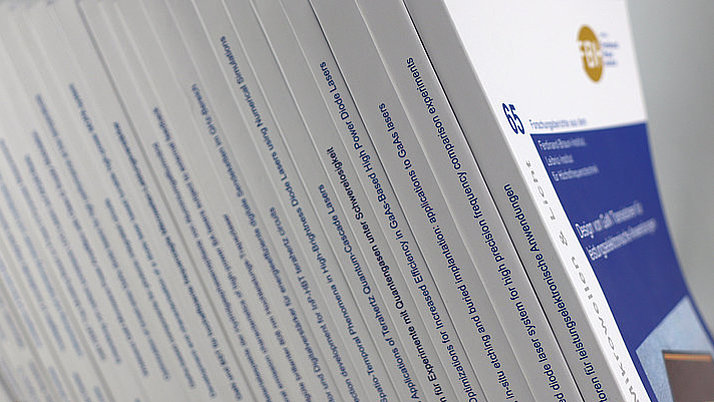Improving the spectral performance of extended cavity diode lasers using angled-facet laser diode chips
M. Krüger1, V.Z. Tronciu2, A. Bawamia1, C. Kürbis1, M. Radziunas3, H. Wenzel1, A. Wicht1, A. Peters1,4, G. Tränkle1
Published in:
Appl. Phys. B, vol. 125, no. 4, p. 125:66 (2019).
Abstract:
We present and compare theoretical and experimental results on the electro-optical performance of extended cavity diode lasers (ECDLs) that employ two ridge waveguide designs for the single-transverse mode GaAs laser diode chip. One facet of the laser diode chips serves as a partially reflective output coupler for the laser cavity. The other facet constitutes an intra-cavity interface which introduces spurious optical feedback to the laser diode chip. The waveguide designs differ with respect to the suppression of this spurious feedback. The first design employs a straight ridge waveguide intersecting both facets at normal incidence. The intra-cavity facet is anti-reflection coated and features a residual intensity reflectivity of the order 10-4. The second design employs a bent ridge waveguide intersecting the anti-reflection-coated intra-cavity facet at an appropriate angle. This provides an additional suppression of the spurious intensity reflection to a value estimated to be less than 10-6. We compare the electro-optical performance of both designs theoretically and experimentally. The utilization of a bent waveguide results in an improved spectral stability and purity, specifically a higher side mode suppression and a small intrinsic spectral linewidth over the whole investigated current range, of the external cavity diode laser without sacrificing other parameters such as the output power. The external cavity diode lasers under study exhibit no degradation of the measured frequency noise power spectra and intrinsic linewidths even if there is a drop of the side mode suppression ratio provided that it is not reduced to a very small value. Thus, the usage of a more readily accessible straight waveguide chip in an ECDL could be sufficient if only a limited tuning range and a particularly compact assembly are needed. For spectroscopic applications requiring a small intrinsic spectral linewidth over a large frequency range a bent waveguide chip could be the better choice.
1 Ferdinand-Braun-Institut, Leibniz-Institut für Höchstfrequenztechnik, Gustav-Kirchhoff-Straße 4, 12489 Berlin, Germany
2 Department of Physics, Technical University of Moldova, bd. Stefan cel Mare 168, 2004 Chisinau, Moldova
3 Weierstrass Institute, Mohrenstraße 39, 10117 Berlin, Germany
4 Institut für Physik, Humboldt-Universität zu Berlin, Newtonstr. 1, 12489 Berlin, Germany
Copyright © Springer-Verlag GmbH Germany, part of Springer Nature 2019. Personal use of this material is permitted. However, permission to reprint/republish this material for advertising or promotional purposes or for creating new collective works for resale or redistribution to servers or lists, or to reuse any copyrighted component of this work in other works must be obtained from the Springer-Verlag.
Full version in pdf-format.


